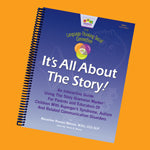Menu
-
- Home
-
About Us
-
The Approach
-
Linking Language & Literacy
-
MindWing Learning
-
Learning Resources
-
SHOP
-
Blog
-
- About MindWing
- Our People
- Contact Us
- Your Account
- Login
-
Spain (EUR €)


StoryBird
December 17, 2013
 StoryBird is very helpful for using technology to develop story telling and story writing skills. However, while providing artwork and a very simple platform for adding text, it does not provide the narrative structure necessary for writing the actual text of the story. Using Story Grammar Marker, students can have the structure to know what parts go into the story. The Common Core State Standards call for the blending of narrative and expository text in lessons as well as integrating technology and multimedia. The following lesson demonstrates it...
StoryBird is very helpful for using technology to develop story telling and story writing skills. However, while providing artwork and a very simple platform for adding text, it does not provide the narrative structure necessary for writing the actual text of the story. Using Story Grammar Marker, students can have the structure to know what parts go into the story. The Common Core State Standards call for the blending of narrative and expository text in lessons as well as integrating technology and multimedia. The following lesson demonstrates it...

Halloween Surprise!
October 07, 2013

October 31 is Halloween. According to history.com, “every October, carved pumpkins peer out from porches and doorsteps in the United States and other parts of the world. Gourd-like orange fruits inscribed with ghoulish faces and illuminated by candles are a sure sign of the Halloween season. The practice of decorating “jack-o’-lanterns”—the name comes from an Irish folktale about a man named Stingy Jack—originated in Ireland, where large turnips and potatoes served as an early canvas. Irish immigrants brought the tradition to America, home of the pumpkin, and it became an integral part of Halloween festivities.”...
The Importance Of Expository Text Comprehension In “Real Life” Situations
August 26, 2011
After a TORNADO, an EARTHQUAKE and now a looming HURRICANE, at MindWing we have become preoccupied by the weather. Usually snowstorms are our biggest threat! The past couple of months of weather have been surreal. We have had workshops cancelled and have spoken to colleagues and friends throughout the east coast who have had school called off due to the hurricane warning.
The paragraph below about Hurricane Irene was found yesterday on http://thesiweather.com/ and exemplifies the IMPORTANCE OF COMPREHENDING EXPOSITORY TEXT IN A “REAL LIFE” SITUATION. Below the paragraph are ThemeMaker® maps organizing the complex, extensive information from this weather report. We thought this could be used for a “content area” lesson...
The Incredible 5-Point Scale and Narrative Elements
April 28, 2011

April is Autism Awareness Month, and I wanted to highlight one of my favorite tools that I employ with students with autism spectrum and related disorders: The Incredible 5-Point Scale by Kari Dunn Baron and Mitzi Curtis. The 5-Point Scale is a tool designed to help students understand the confusing, emotional and language-heavy range of human behaviors by boiling it all down to a scale of 1-5. The approach is very versatile and can be applied to many situations and target behaviors, such as emotional state, voice volume or scales to help students grade their responses to everyday occurrences such as a “Participation Scale” within the classroom...

Dinosaurs, Narrative, and Flexible Thinking
March 02, 2011 2 Comments

I always love finding resources that serve as a context for addressing many speech and language-related skills. The wonderful book Edwina — The Dinosaur Who Didn’t Know She was Extinct by Mo Willems is one of those resources; it can be used to target narrative and expository formulation, as well as social thinking skills in several areas.
To begin with, Edwina is a story that will engage and delight children from early to late elementary ages, beginning with its title and the name of the main character, Reginald Von Hoobie-Doobie. Reginald has a problem...

Interactive, Visual Resources to Complement Feelings Instruction (Internal Responses)
January 31, 2011
 As stated so well in It’s All About The Story, Book I of MindWing’s Autism Collection, “Tuning into one’s own Feelings as well as the Feelings of Others is extremely problematic to children with autism. The book provides visual flip charts, discussion prompts and an introduction to the Six Universal Feelings (happy, sad, mad, scared, surprised and disgusted), as well as ways to move beyond those Universal categories to more advanced feelings vocabulary—all of these resources give SLPs a great place to start...
As stated so well in It’s All About The Story, Book I of MindWing’s Autism Collection, “Tuning into one’s own Feelings as well as the Feelings of Others is extremely problematic to children with autism. The book provides visual flip charts, discussion prompts and an introduction to the Six Universal Feelings (happy, sad, mad, scared, surprised and disgusted), as well as ways to move beyond those Universal categories to more advanced feelings vocabulary—all of these resources give SLPs a great place to start...
